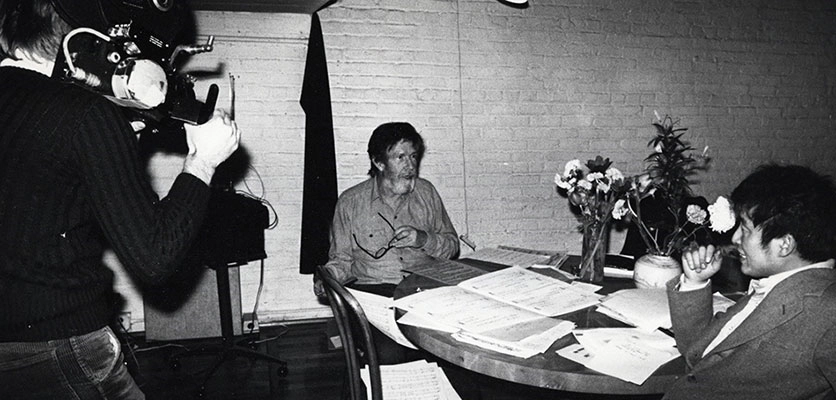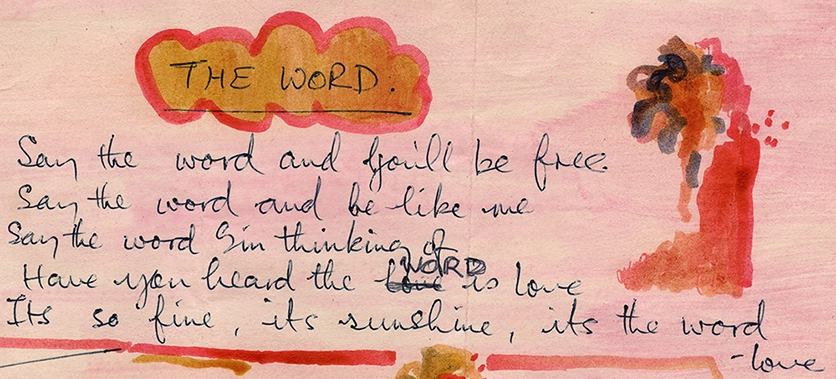John Cage Collection
I can’t understand why people are frightened of new ideas. I’m frightened of the old ones.”
— John Cage
John Cage (1912-1992) is one of the most inventive composers in American history. Through innovations such as the prepared piano, use of chance operations in composing, and using common transistor radios as instruments, he continually challenged our understanding of music. Cage’s lectures and writings are held in equal esteem to his musical compositions.
The John Cage Collection is a major research collection containing correspondence, the Notations project scores, and ephemeral materials. Additionally, the collection contains a handful of his musical manuscripts including Music of Changes (1951), the first work utilizing the I Ching. The collection documents Cage's entire life through primary source materials, and has been central to many important publications.

The correspondence collection holds letters, cards, clippings, photographs, tapes, musical scores, and visual art. Many of Cage’s artistic partners and associates are well represented including Merce Cunningham, Jasper Johns, Robert Rauschenberg and Morton Feldman.
The Notations Project collection contains all 463 works and related correspondence gathered by Cage. Working with Alison Knowles, Cage communicated with hundreds of composers, artists, and writers to solicit manuscripts for inclusion in a book to benefit the Foundation for Contemporary Performance Arts. Cage published selections as Notations (New York: Something Else Press, 1969). Highlights of the collection include Pierre Boulez's Second Piano Sonata, Morton Feldman's The King of Denmark, and Steve Reich's Piano Phase.
Collection Series
The John Cage Collection is organized into six series and two sub-series. Plan a visit to the McCormick Library to view materials by appointment. Request materials and appointments through the finding aids below.
| Series | Description | Access |
|---|---|---|
|
I. Correspondence, 1909-1993; n.d. |
Letters, documents, and other correspondence to and from Cage |
Partially digitized: |
|
II. Notations Project, 1884-1990 (bulk 1960-1969); n.d. Sub-series 1: Manuscripts Sub-series 2: Correspondence |
Music manuscripts by 274 composers collected by Cage for his book, Notations (New York: Something Else Press, 1969); related correspondence |
|
|
III. Scores, 1914-1975; n.d. |
Various music manuscripts in Cage’s possession |
Search in the library catalog |
|
IV. Scrapbooks, 1917-1951; n.d. |
Nine scrapbooks with photographs and other records of Cage's childhood and formative years |
View in Digital Collections (must be logged in with NetID) |
|
V. Ephemera, 1909-1995; n.d. |
Wide variety of items collected by Cage, including programs, articles, books, clippings, and other materials |
|
|
VI. Correspondence Addenda, 1941-1992; n.d. |
Correspondence related to Cage but acquired separately |
Beatles Manuscripts
In the mid 1960s, composer John Cage undertook a project to collect manuscripts by musicians of that era. Along with works of Cage, Aaron Copland, Igor Stravinsky, Pierre Boulez, and over 250 other composers, Cage obtained a handful of original lyric sheets for songs by the Beatles. At the time Cage did not know the Beatles personally, but he was in touch with artist Yoko Ono, who had just entered the Beatles’ circle and arranged for the manuscripts to be sent to Cage. Cage received lyric sheets for seven songs: “The Word,” “Eleanor Rigby,” “I’m Only Sleeping,” “Yellow Submarine”, “Good Day Sunshine,” “And Your Bird Can Sing” (showing the working title “You Don’t Get Me”), and “For No One” (with the working title “Why Did It Die?” and some lyrics not heard in the recorded version). All songs are from Revolver (1966), except for “The Word,” from Rubber Soul (1965).

Due to their value, the original manuscripts are only exhibited occasionally. Copyright restrictions prevent Northwestern from making full images of the manuscripts available online. For more information, see Hunter Davies’ book, The Beatles Lyrics: The Stories Behind the Music.